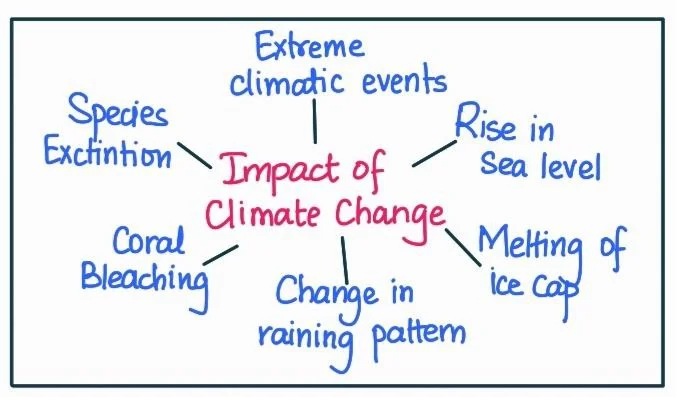Answer:
| Approach:
Introduction
- Brief about Climate change.
Body
- Discuss India’s vulnerabilities and regional consequences by climate change impact.
- Write about the impact of Climate Change on Himalayan and coastal states of India.
Conclusion
- Conclude your answer sustainable Approach to climate change.
|
Introduction:
Climate change is a global problem that affects every country, including India. The changing climate patterns have caused severe impacts on the environment, economy, and society, and the effects are expected to worsen in the future.

Body:
- Impacts of Climate Change on India: Climate change has already started to affect India in various ways, including changes in rainfall patterns, temperature, and extreme weather events. The agricultural sector is particularly vulnerable, with erratic rainfall patterns affecting crop yields and food security. Climate change also affects public health, water availability, and biodiversity. Like increased droughts in Maharashtra and flooding in Assam.
- Effects on Himalayan States: Himalayan states are particularly vulnerable to climate change impacts due to their sensitive ecosystems and unique topography. The melting of glaciers and snow cover has led to increased risks of floods, landslides, and water scarcity. The region is also prone to disasters such as cloudbursts and flash floods. Like Himalayan states like Uttarakhand and Himachal Pradesh are witnessing the melting of glaciers, leading to increased risks of floods and landslides.
- Effects on Coastal States: Coastal states are also vulnerable to climate change impacts, with sea-level rise posing a significant threat to coastal communities and infrastructure. The increased frequency and intensity of cyclones, storm surges, and saltwater intrusion are also causing severe damage to the coastal regions. E.g Coastal states such as Gujarat and Odisha are experiencing the impact of sea-level rise, posing a threat to communities and infrastructure.
Climate change is a global phenomenon that affects the entire planet:
- Himalayan states: Uttarakhand, Himachal Pradesh, and Jammu & Kashmir are already experiencing the impacts of climate change in the form of rising temperatures, erratic rainfall, and melting glaciers. The Gangotri glacier in Uttarakhand has been retreating rapidly, which is affecting the flow of the Ganges river, on which millions of people depend for their livelihoods.
- Coastal states: Kerala, Tamil Nadu, and Odisha are facing the risk of sea-level rise, which could lead to flooding and erosion of coastlines. The frequency and intensity of cyclones are also increasing, which can cause massive damage to property and infrastructure. g Cyclone Gaja hit the coastal districts of Tamil Nadu, causing widespread destruction and loss of life.
Conclusion:
Climate change is a pressing issue that requires immediate attention in India. The Himalayan and coastal states are particularly vulnerable to the impacts of climate change, with implications for the environment, the economy, and society. India must take proactive measures to adapt to the changing climate and mitigate greenhouse gas emissions to limit the extent of the impacts.
